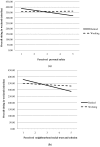Social and physical environmental correlates of adults' weekend sitting time and moderating effects of retirement status and physical health
- PMID: 25243886
- PMCID: PMC4199050
- DOI: 10.3390/ijerph110909790
Social and physical environmental correlates of adults' weekend sitting time and moderating effects of retirement status and physical health
Abstract
Emerging research suggests that prolonged sedentary behaviour (SB) is detrimental to health. Changes in SB patterns are likely to occur during particular life stages, for example at retirement age (55-65-year-old). Evidence on socio-ecological SB correlates is scarce and inconsistent in this age group. Moreover, the influence of socio-ecological correlates may vary depending on health and retirement status. This study examined social and environment correlates of overall weekend day sitting among adults at or approaching retirement age, and moderating effects of perceived physical health and retirement status. Baseline data from the Wellbeing, Eating and Exercise for a Long Life study in 2839 Australian adults (55-65-year-old) were analysed. Participants self-reported proximal social factors, neighbourhood social and physical environment, physical health and retirement status. MLwiN multilevel regression analyses were conducted. In the multivariable model, only social support from friends/colleagues to discourage sitting (B = -0.891; p = 0.036) was associated with overall weekend day sitting. No moderation of retirement status, nor physical health were found in the multivariable results. Results from this study suggest the importance of social factors in relation to weekend day sitting among 55-65-year-old adults. Health promotion initiatives in this age group should pay special attention to enhancing social interaction opportunities. Moreover, findings suggest that SB-specific correlates may need to be examined in future research.
Figures
Similar articles
-
Educational inequalities in TV viewing among older adults: a mediation analysis of ecological factors.Int J Behav Nutr Phys Act. 2013 Dec 19;10:138. doi: 10.1186/1479-5868-10-138. Int J Behav Nutr Phys Act. 2013. PMID: 24350830 Free PMC article.
-
Which psychological, social and physical environmental characteristics predict changes in physical activity and sedentary behaviors during early retirement? A longitudinal study.PeerJ. 2017 May 11;5:e3242. doi: 10.7717/peerj.3242. eCollection 2017. PeerJ. 2017. PMID: 28507817 Free PMC article.
-
The role of socio-demographic factors and physical functioning in the intra- and interpersonal variability of older adults' sedentary time: an observational two-country study.BMC Geriatr. 2022 Jun 9;22(1):495. doi: 10.1186/s12877-022-03186-1. BMC Geriatr. 2022. PMID: 35681115 Free PMC article.
-
Correlates of physical activity and sedentary behaviour in the Thai population: a systematic review.BMC Public Health. 2019 Apr 16;19(1):414. doi: 10.1186/s12889-019-6708-2. BMC Public Health. 2019. PMID: 30991973 Free PMC article.
-
Correlates of sedentary behaviour in Asian adults: A systematic review.Obes Rev. 2020 Apr;21(4):e12976. doi: 10.1111/obr.12976. Epub 2020 Jan 9. Obes Rev. 2020. PMID: 31919972
Cited by
-
Associations of Mentally Active Versus Passive Sedentary Behavior with Overweight/Obesity in Adults: Role of Patterns and Sex.Healthcare (Basel). 2025 Feb 8;13(4):361. doi: 10.3390/healthcare13040361. Healthcare (Basel). 2025. PMID: 39997236 Free PMC article.
-
Interactions between Neighborhood Social Environment and Walkability to Explain Belgian Older Adults' Physical Activity and Sedentary Time.Int J Environ Res Public Health. 2016 Jun 7;13(6):569. doi: 10.3390/ijerph13060569. Int J Environ Res Public Health. 2016. PMID: 27338426 Free PMC article.
-
Associations of functional disability and behavioural risk factors with social participation of older adults: a cross-sectional analysis from the Canadian Longitudinal Study on Aging.BMJ Open. 2022 Jan 19;12(1):e052173. doi: 10.1136/bmjopen-2021-052173. BMJ Open. 2022. PMID: 35045997 Free PMC article.
-
Social engagement pattern, health behaviors and subjective well-being of older adults: an international perspective using WHO-SAGE survey data.BMC Public Health. 2020 Jan 23;20(1):99. doi: 10.1186/s12889-019-7841-7. BMC Public Health. 2020. PMID: 31973695 Free PMC article.
-
The Influence of Neighbourhoods and the Social Environment on Sedentary Behaviour in Older Adults in Three Prospective Cohorts.Int J Environ Res Public Health. 2017 May 24;14(6):557. doi: 10.3390/ijerph14060557. Int J Environ Res Public Health. 2017. PMID: 28538672 Free PMC article.
References
-
- United Nations Department of Economic and Social Affairs World Population Ageing. [(accessed on 9 November 2012)]. Available online: http://www.un.org.
-
- Rockwood K., Howlett S.E., MacKnight C., Beattie B.L., Bergman H., Hébert R., Hogan D.B., Wolfson C., McDowell I. Prevalence, attributes, and outcomes of fitness and frailty in community-dwelling older adults: Report from the Canadian study of health and aging. J. Gerontol. Ser. A-Biol. Sci. Med. 2004;59:1310–1317. - PubMed
-
- Kennedy E.T. Evidence for nutritional benefits in prolonging wellness. Amer. J. Clin. Nutr. 2006;83:S410–S414. - PubMed
Publication types
MeSH terms
LinkOut - more resources
Full Text Sources
Other Literature Sources
Medical



